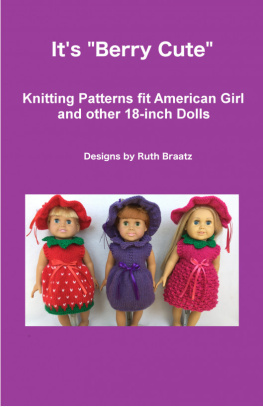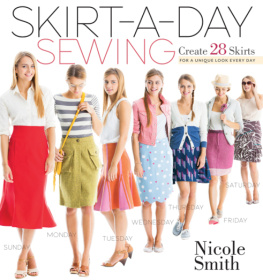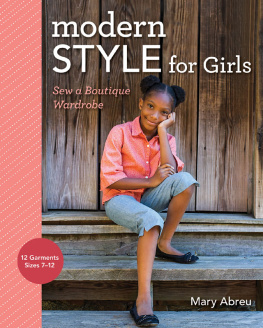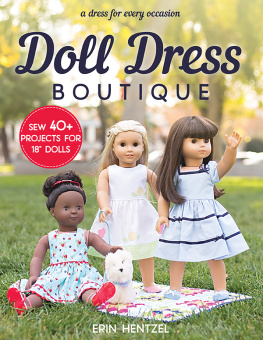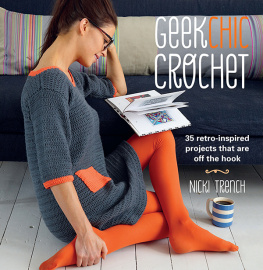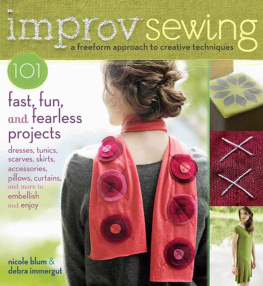


To Matilda
Text copyright 2016 by Theresa Gonzalez
Photographs copyright 2016 by Nicole Hill Gerulat
All rights reserved. No part of this book may be reproduced in any form without written permission from the publisher.
Library of Congress Cataloging-in-Publication Data available.
ISBN 978-1-4521-3868-8 (pb)
ISBN 978-1-4521-4390-3 (epub, mobi)
Design by Jennifer Tolo Pierce
Wonder Tape is a registered trademark of Ranger Industries, Inc.
Chronicle Books LLC
680 Second Street
San Francisco, California 94107
www.chroniclebooks.com
CONTENTS
INTRODUCTION
IS IT SUNDAY YET?
You may have picked up this book for many reasons: you were drawn to the cover project and needed the instructions to make it. You are learning to sew and seeking out simple, modern patterns for the season. You were inspired by the clean design and photography. Whatever your reason, welcome! Im happy to have you here.
Inside, youll find twenty sewing patterns that you can make, modify, embellish, and share in a day or two, depending on your skill level. For beginners, I provide plenty of guidance and instruction to lead you through every project. For intermediate to advanced sewers, you may find these patterns on the easy side but definitely not boring to sew. The timeless silhouettes lend themselves to a wearable collection youll want to keep for years to comejust freshen up the patterns with new fabrics as you go.
Why Sunday? Well, its that day of leisure when you do what you will, whether your routine involves a city brunch with friends, services with family, a lazy day with your love, or time for yourself to be creative. Youre well rested from a busy workweek by now and have more time to focus on your craft. After all, no matter how basic the project, sewing requires patience and precisiona tired sewer likely wont produce the best results (as Ive learned...). I also prefer to sew in daylightwith pins and stitching in clear viewand blocking time on a Sunday in a clean house (or at least tidy craft room) sets you up in ideal surroundings to construct a project that you absolutely love.
to tote along to your local farmers market or favorite shopping district. While many of the designs are fashion projects, youll also find gift items to give at baby showers and birthdays. Along the way, pick up lessons like machine-stitching buttonholes, installing lapped and exposed zippers, working with rivets and leather straps, as well as shaping your garments with darts and pleats.
To get more mileage from the patterns, including making them for yourself and for someone else in a different size, check out .
Lastly, please share your work-in-progress as well as your completed projects on Instagram and Twitter using #sundaysewsbook so we can all share successes and roadblocks along the way. Thanks to the wonders of social media, sewing no longer has to be a solitary craft, as I suggest in my acknowledgments. To that end, I look forward to catching up with all of you in the virtual craft spaceevery Sunday.
Enjoy,
Theresa
PART I: Sewing Techniques
THE BASICS
ABOUT FABRIC
The right or wrong fabric can make or break a project. Imagine a drapey dress made in lightweight linen. Now imagine the same dress in heavyweight denim; it simply wont have the right look or feel. The denim would be a better choice for a tote or an apron where its sturdiness is an asset. Fabric choice makes a significant difference in both the wearability of your finished project and your sewing experience. When I designed the projects in this book, I paired a specific fabric with each onemostly light- to medium-weight cottons and linens in classic prints. Because they are so easy to sew and wear, I think they are perfect for the stylishly simple projects that youll find in this book. For the best results I recommend using the fabric suggested, especially the first time you make a given project.
FIBERS
Cotton
Cotton is a great fabric for beginner sewers. Its relatively inexpensive, so if you make mistakes youre not out of a lot of money. Its a strong fabric that doesnt stretch, which means its less likely to snag, and is machine washable, comfortable to wear, and comes in many great prints. Its also available in a variety of weights and weavesfrom shirting to chambray, corduroy, organdy, and more.
Linen
Linen is a natural fiber thats sourced from the flax plant. Its even stronger than cotton, so you can expect less wear and tear over time. Like cotton, linen comes in many weights and textures, from chambray to twill to shirting. Heavyweight linens are recommended for home dcor projects and light- to medium-weight materials for your fashion projects. Before choosing a linen, test the fabrics hand (meaning the weight and feel of the fabric) against your skin to make sure its right for the project you plan to make.
ANATOMY
Before you start cutting your fabric, take note of its specific make-up. First, see (uncut) edgeyoull often see the fabric details printed on it. These are the longest and strongest threads. The crosswise grain runs from selvage to selvage. When you lay out the pattern pieces, youll want to line them up with the fabrics grain linesusually with the lengthwise grain of the fabricto prevent puckering and unflattering shapes in the final garment. On pieces where this matters, youll see a long arrow printed on the pattern piece to indicate how to orient the paper on the fabric.
When a project or pattern says Right side of fabric, its referring to the side of the fabric you want to show in the finished project. The Wrong side is the side you dont want to show. In a printed cotton fabric, youll find that its pretty obvious which is the Right side and which is the Wrong side. (Most cottons are rolled on the boltthat is, the large roll youll see at fabric storeswith the Right side facing out.) If youre working with a solid-colored fabric, be sure to mark the Right and Wrong side so youll know which is which when youre cutting out your fabric. Mistaking the two can create a noticeable difference in your final garment, and can ruin the outcome. If youre unsure of what the fabrics Right side is, just choose which side you like best and mark that side as the Right side throughout using a marking tool such as a chalk marking pencil or water-soluble pen .
I use nondirectional patterned fabrics for all but one project. Nondirectional fabrics feature prints that look the same when placed upside down as they do when right-side up (such as stripes, plaids, circles) and therefore are easy for beginner sewers to use.
The Matilda Dress on so the arrows point upward along the vertical centerline of the dress. When creating this dress or any garment using a directional patterned fabric, make sure to cut the pattern pieces from the fabric so the front and back pieces match. The cutting layout for the Matilda Dress lays out the pattern pieces in the same direction to ensure this.
Figure 1

Many cutting layouts in this book, however, instruct you to place pattern pieces on the fabric in opposite directions, which makes the best use of space and reduces fabric waste. This is fine for the nondirectional prints used in this book. If youd prefer to use a directional print fabric, you will need to alter the cutting layout in order to cut out pieces that match. Ive noted the projects in which you will need to alter the cutting layout. In these cases, carefully choose the direction in which youd like to see your print on the finished project, and note that changing the cutting layout might require more fabric.
Next page


